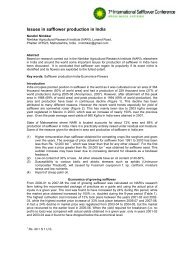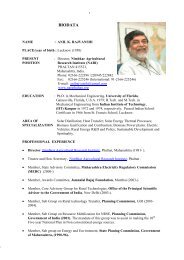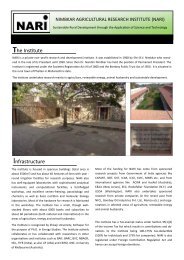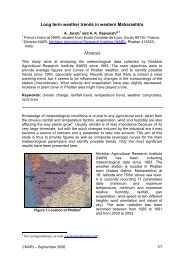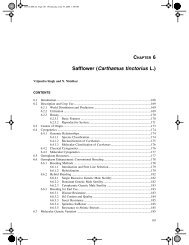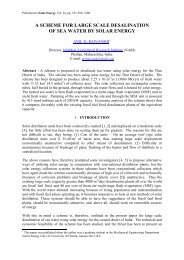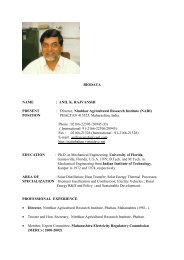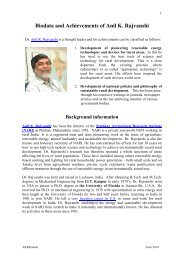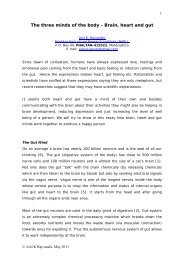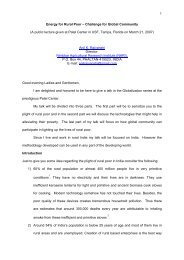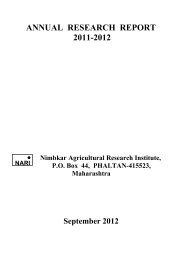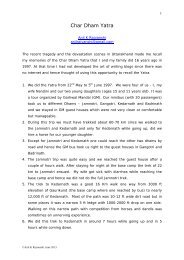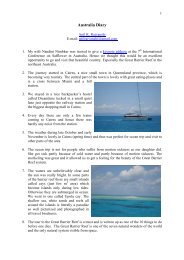Create successful ePaper yourself
Turn your PDF publications into a flip-book with our unique Google optimized e-Paper software.
Multipurpose <strong>sweet</strong>-stalked <strong>sorghum</strong> hybrid - ‘MADHURA’<br />
Developed by Nimbkar Agricultural Research Institute (<strong>NARI</strong>)<br />
Sweet-stalked <strong>sorghum</strong> [Sorghum bicolor<br />
(L.) Moench] is a multipurpose crop,<br />
which stores sugar in its stem. It can<br />
produce grain from its earhead and the<br />
stem can produce sugary juice, which can<br />
be used for syrup or jaggery production or<br />
can be fermented to produce ethanol for<br />
energy purpose. The bagasse and the<br />
stripped leaves make an excellent fodder<br />
for animals.<br />
The Nimbkar Agricultural Research<br />
Institute (<strong>NARI</strong>) has been working on this<br />
crop for last more than 25 years and has<br />
developed a hybrid called “MADHURA”.<br />
Hybrid “Madhura” is not only suitable for<br />
preparation <strong>of</strong> ethanol and good quality<br />
syrup and jaggery, but it also produces<br />
high grain and fodder yields. <strong>NARI</strong> has<br />
developed the technology for chemicalfree<br />
syrup production from <strong>sweet</strong> <strong>sorghum</strong><br />
stalk juice.<br />
Salient features <strong>of</strong> hybrid “Madhura":<br />
• Hybrid “Madhura” is suitable for year<br />
round production and it matures in<br />
115-125 days.<br />
• It gives high grain yield in rabi season<br />
and produces high stalk yield in both<br />
kharif and summer seasons.<br />
• Yield performance <strong>of</strong> “Madhura”<br />
from one hectare.<br />
Produce<br />
Weight (Tons)<br />
Green fodder 60-80<br />
Stripped stalk 40-55<br />
Green leaves 3.5-4.0<br />
Grain 1.5-2.0<br />
Syrup 3.0-5.5 (Brix : 74–75%)<br />
Jaggery 2.0-3.0<br />
‘Madhura’ A <strong>sweet</strong>-stalked <strong>sorghum</strong><br />
hybrid (Field view)<br />
• Quality and quantity parameters <strong>of</strong><br />
hybrid “Madhura” for syrup.<br />
Juice extractability : 40-50%<br />
Brix <strong>of</strong> juice : 17-23.5%<br />
Syrup recovery : 8-11.5% (on<br />
stripped stalk<br />
weight basis).<br />
• If syrup or jaggery production is not<br />
possible, stalks can be used as fodder<br />
for cattle. Increase in milk yield upto<br />
20% in milch cattle has been seen after<br />
feeding them fodder from hybrid<br />
‘Madhura’.<br />
• A ratoon crop can be taken for grain<br />
and/or fodder.<br />
• Syrup prepared from the hybrid is rich<br />
in calcium, proteins, vitamin C and<br />
nicotinic acid. Due to its lower<br />
production cost, it may become a<br />
good alternative to honey.<br />
©<strong>NARI</strong> 2006 1
Package <strong>of</strong> practices :<br />
1) Climate : ‘Madhura’ hybrid can be<br />
grown under diverse climatic<br />
conditions. The mean maximum and<br />
mean minimum temperatures under<br />
which it can be grown range from 30<br />
to 36 0 C and 15 to 20 0 C, respectively.<br />
The range <strong>of</strong> average temperatures for<br />
its satisfactory growth is 27 to 30 0 C.<br />
2) Soil and preparatory tillage<br />
operations : Well-drained heavy to<br />
medium soil is suitable for this crop.<br />
The soil should be ploughed followed<br />
by two to three harrowings. Before<br />
last harrowing, 10-15 cartloads <strong>of</strong><br />
well-decomposed manure per hectare<br />
should be mixed in the soil.<br />
3) Season : Kharif and summer are the<br />
ideal seasons for growing “Madhura”.<br />
It can also be grown during winter<br />
(rabi) season with 20% reduction in<br />
stalk yield, but with more grain yield.<br />
4) Sowing method :<br />
a) For syrup : The sowing should<br />
preferably be done on ridges and<br />
furrows under irrigated condition,<br />
but under rainfed condition<br />
normal drilling can be followed.<br />
The distance should be 45 to 60<br />
cm between two rows and 15 to 20<br />
cm between two plants within a<br />
row. Average plant population<br />
should be 1.0 to 1.5 lakh/ha.<br />
b) For fodder : For fodder purpose<br />
the inter and intra row spacings<br />
should be 45 cm and 10 to 15 cm<br />
respectively. Average plant<br />
population should be 2.0 to 2.5<br />
lakh/ha.<br />
5) Seed rate : For syrup and grain : 7.5<br />
kg/ha and for fodder : 15 kg/ha.<br />
6) Sowing time :<br />
Kharif (Monsoon) : First fortnight <strong>of</strong><br />
June<br />
Rabi (Winter) : From last week<br />
<strong>of</strong> September to<br />
second week <strong>of</strong><br />
October.<br />
Summer : From January to<br />
February end.<br />
7) Fertilizers : A fertilizer dose <strong>of</strong><br />
80:40:40 kg, N:P:K/ha at the time <strong>of</strong><br />
sowing is optimum under rainfed<br />
condition. A fertilizer dose <strong>of</strong><br />
100:50:50 kg N:P:K/ha is<br />
recommended for sowing under<br />
irrigated conditions. Half <strong>of</strong> the total<br />
nitrogen and full dose <strong>of</strong> phosphorus<br />
and potassium should be given at the<br />
time <strong>of</strong> sowing, while the remaining<br />
half <strong>of</strong> nitrogen should be given in two<br />
equal doses either at 30-35 and 65-70<br />
days after sowing or at one time, 35<br />
days after sowing followed by<br />
irrigation.<br />
8) Intercultivation : Thinning should be<br />
done at 20-30 days after sowing. In<br />
case <strong>of</strong> excessive tillering caused due<br />
to shootfly damage, tillers should be<br />
removed for getting uniform stalk size.<br />
Weeding two to three times at 3, 5 and<br />
7 weeks after sowing not only helps to<br />
check weed growth but also conserve<br />
soil moisture by providing top soil<br />
mulch.<br />
9) Irrigation management : Under<br />
irrigated conditions in medium to deep<br />
soils it is desirable to give four<br />
irrigations - one each at panicle<br />
initiation, boot, bloom and grain<br />
filling stages. In case <strong>of</strong> limited<br />
availability <strong>of</strong> irrigation water, it can<br />
be restricted even to one irrigation at<br />
panicle initiation (35 DAS) or boot<br />
stage (60 DAS). In summer season, 8-<br />
10 irrigations are required.<br />
©<strong>NARI</strong> 2006 2
10) Plant protection :<br />
Major pests<br />
a) Shootfly (Atherigona soccata) : It<br />
is a seedling pest and normally<br />
occurs 1 to 4 weeks after<br />
germination. Larvae feed on the<br />
growing tip causing wilting <strong>of</strong><br />
inner leaf whorl and later drying <strong>of</strong><br />
newest leaf giving a typical ‘dead<br />
heart’ appearance Shootfly attack<br />
can be controlled by suitable<br />
adjustment <strong>of</strong> the sowing time. In<br />
kharif, sowing before June 15 and<br />
in rabi sowing from September end<br />
to first week <strong>of</strong> October is ideal to<br />
escape shootfly damage.<br />
Carb<strong>of</strong>uran 3% granules @ 20<br />
kg/ha at the time <strong>of</strong> sowing as soil<br />
application along with seed can<br />
furrows can effectively check the<br />
pest incidence. In case soil<br />
application is not done, damage<br />
can be minimised by spraying the<br />
seedlings at 7 and 14 days’ age<br />
with endosulfan 35 EC @ 2 ml/lit<br />
<strong>of</strong> water.<br />
b) Stem borer (Chilo partellus) :<br />
The pest infests the crop from<br />
second week after sowing till<br />
maturity. The larvae initially feed<br />
on the growing point <strong>of</strong> the plant,<br />
which results in dead heart and<br />
then they move down the outside<br />
<strong>of</strong> the stem, and bore into it just<br />
above an internode. This adversely<br />
affects the quality <strong>of</strong> syrup if<br />
prepared from the infested stalks.<br />
It can be controlled by whorl<br />
application <strong>of</strong> endosulfan<br />
4G/4D, carbaryl 3G, malathion<br />
10D or carb<strong>of</strong>uran 3G @ 8-12<br />
kg/ha at 30 to 35 days after<br />
emergence.<br />
Sporadic pests<br />
a) Shoot bug (Peregrinus maidis) :<br />
Heavy infestation is seen on the<br />
crop, especially during rabi season<br />
when rain occurs at seedling<br />
stage. The adults and nymphs<br />
suck the plant sap causing reduced<br />
plant vigor and yellowing. Heavy<br />
infestation at vegetative stage may<br />
twist the top leaves and prevent<br />
either the formation or emergence<br />
<strong>of</strong> panicles. Application <strong>of</strong><br />
endosulfan 4G or carbaryl 3G<br />
@ 8 kg/ha in the whorls can<br />
effectively check the incidence <strong>of</strong><br />
the pest.<br />
b) Aphids (Rhopalosiphum maidis)<br />
: Attack during boot stage may<br />
result in poor panicle exsertion.<br />
Both the adults and nymphs suck<br />
the sap and heavily infested leaves<br />
show yellowish blotches.<br />
Necrosis may occur on leaf edges.<br />
Severe damage is noticed under<br />
moisture stress conditions<br />
resulting in drying <strong>of</strong> leaves as<br />
well as plant death. Spraying <strong>of</strong><br />
oxydemeton-methyl 35 EC @ 1<br />
litre in 500 litre water per<br />
hectare effectively controls<br />
aphids.<br />
c) Midge (Contarinia sorghicola) :<br />
The adult <strong>of</strong> the pest deposits eggs<br />
in flowers and the larvae feed on<br />
the ovaries, causing chaffiness <strong>of</strong><br />
the earhead. To control the pest,<br />
one <strong>of</strong> the following insecticides<br />
should be dusted or sprayed when<br />
1-2 midge adults per earhead are<br />
seen.<br />
i) Malathion 5% dust,<br />
endosulfan 4% dust or<br />
quinalphos 1.5% dust @ 20<br />
kg/ha<br />
or<br />
ii) Malathion 50 WP (100 ml),<br />
carbaryl 50 WP (2 kg) or<br />
endosulfan 35 EC (700 ml) in<br />
500 litre water/ha.<br />
©<strong>NARI</strong> 2006 3
Major diseases<br />
a) Leaf blight (Exserohilum<br />
turcicum) : This disease occurs<br />
under cloudy and humid<br />
conditions. The necrotic areas<br />
are more than 2.5 cm long and<br />
narrow with a straw-colored<br />
center. To control it spray<br />
1250 g <strong>of</strong> either mancozeb or<br />
copper oxychloride in 500<br />
litre water/ha. Seed treatment<br />
with thiram @ 2.0 g/kg is also<br />
effective.<br />
b) Charcoal rot (Macrophomina<br />
phaseolina) : S<strong>of</strong>tening <strong>of</strong><br />
basal stalk, lodging and poor<br />
grain filling are the evident<br />
external symptoms. The lower<br />
stem regions <strong>of</strong> the infected<br />
plants become s<strong>of</strong>t, discolored<br />
and hollow resulting in lodging.<br />
Losses in grain yield and<br />
reduced seed size occur due to<br />
premature drying and lodging.<br />
Soil treatment with thiram @<br />
4.5 kg/ha at sowing can reduce<br />
the charcoal rot by 15%.<br />
11) Harvesting : The crop can be<br />
harvested after the grain becomes<br />
physiologically mature. First the<br />
panicles are harvested and then the<br />
stalk can be harvested within 15-20<br />
days for syrup, jaggery or alcohol<br />
production.<br />
Important hints :<br />
i) For fodder, the crop can be<br />
harvested just after flowering<br />
(i.e.70-75 days after sowing).<br />
ii)<br />
For syrup, jaggery or alcohol<br />
production, the stalks should be<br />
harvested within 15-20 days <strong>of</strong><br />
grain maturity as after that the stalk<br />
weight and sugar percentage in<br />
juice may be reduced.<br />
iii) Before extracting the juice,<br />
especially for syrup or jaggery<br />
production, the stalks should be<br />
stripped <strong>of</strong> leaves.<br />
iv)<br />
The stalks should be crushed as<br />
soon as possible after harvest for<br />
jaggery production and 12-18<br />
hours after harvest for syrup<br />
production. In any case juice<br />
extraction should be carried out<br />
within 24 hours <strong>of</strong> harvest.<br />
Ratooning : A ratoon <strong>of</strong> hybrid<br />
“Madhura” can be taken for grain and<br />
fodder. After harvesting, a fertilizer dose<br />
<strong>of</strong> 50 kg each <strong>of</strong> N:P:K per hectare<br />
should be applied and the crop should be<br />
irrigated. Ratoon crop is ready for harvest<br />
within 90 days.<br />
For seed and other details please contact :<br />
<strong>NARI</strong><br />
President<br />
Nimbkar Agricultural Research Institute,<br />
P.O. Box 44,<br />
PHALTAN-415523, Maharashtra, India.<br />
Telephone : Office : 91-2166-222396<br />
Fax : 91-2166-220945<br />
E-mail : nariphaltan@gmail.com<br />
Webpage : http://nariphaltan.virtualave.net<br />
©<strong>NARI</strong> 2006 4



